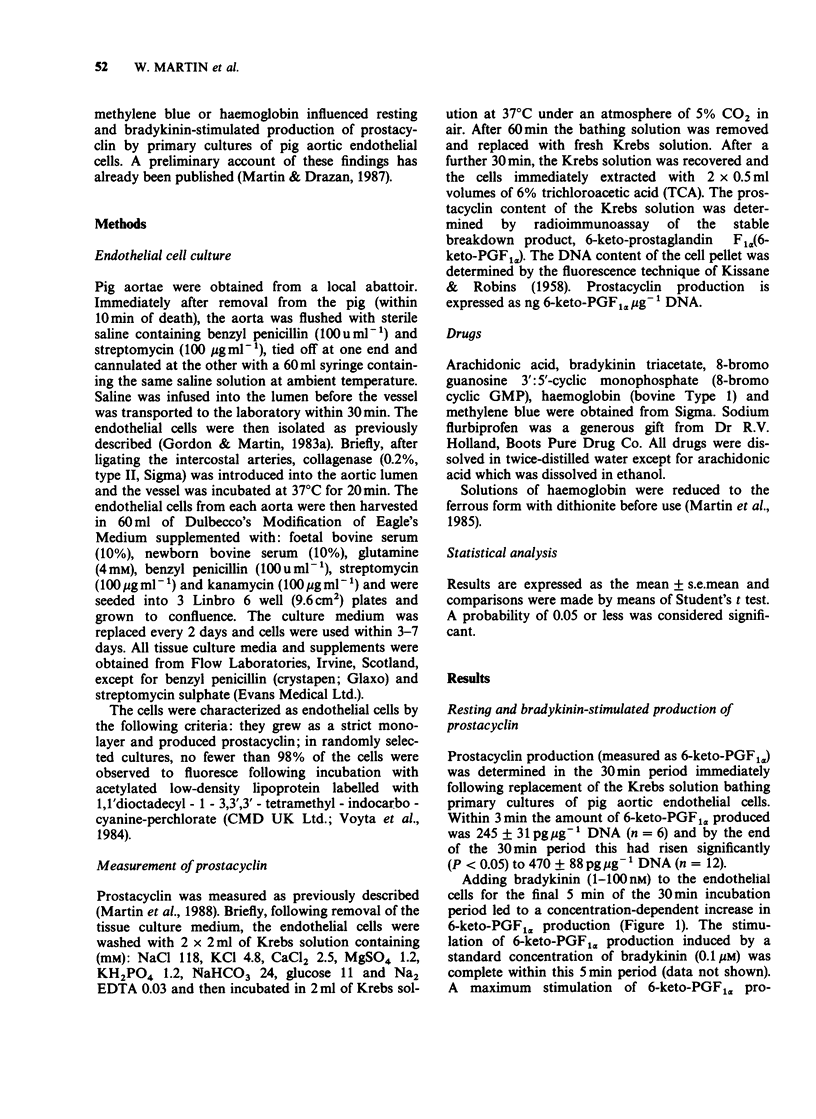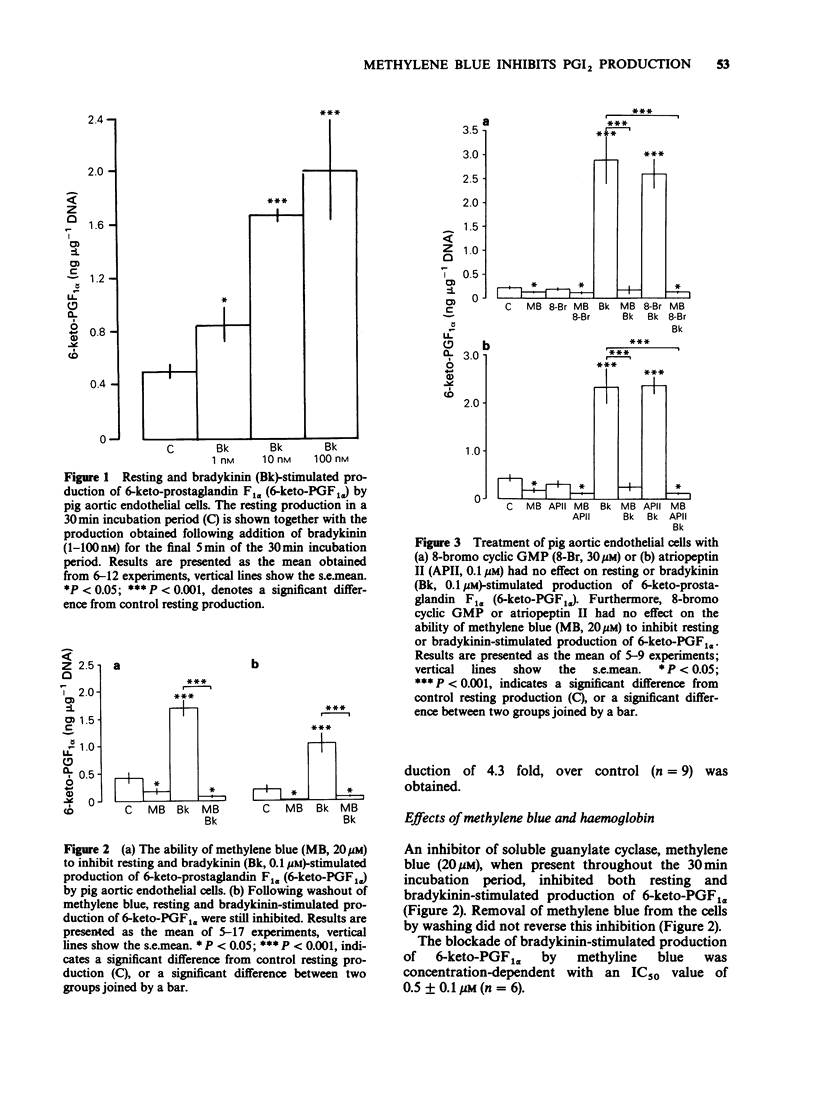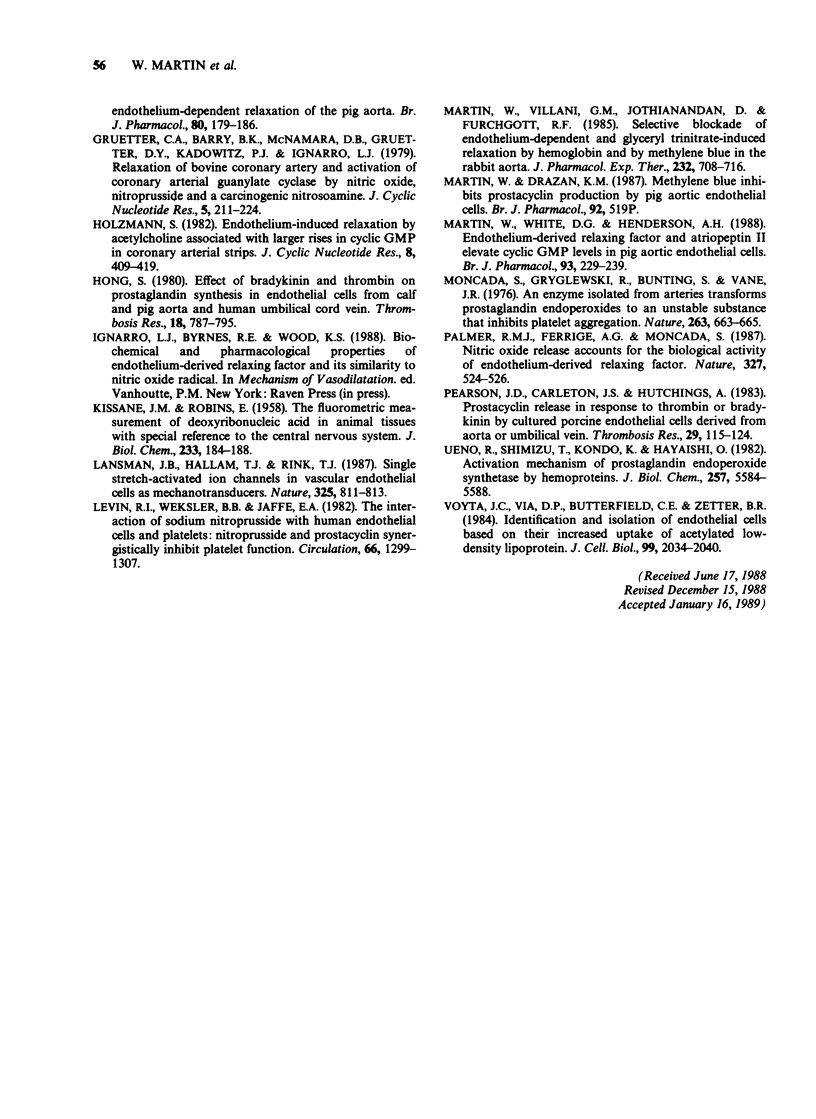Abstract
1. Primary cultures of pig aortic endothelial cells produced 6-keto-prostaglandin F1 alpha (6-keto PGF1 alpha), the stable breakdown product of prostacyclin, both in the resting state and in response to bradykinin. The rise in 6-keto-PGF1 alpha production induced by bradykinin (1-100 nM) was concentration-dependent. 2. Treating endothelial cells with the inhibitor of soluble guanylate cyclase, methylene blue (0.1-20 microM) produced an irreversible reduction in resting and bradykinin (0.1 microM)-stimulated production of 6-keto-PGF1 alpha with an IC50 of 0.5 +/- 0.1 microM. Treating endothelial cells with haemoglobin (10 microM) had no effect on resting or bradykinin (0.1 microM)-stimulated production of 6-keto-PGF1 alpha. 3. Two stimuli that elevate the level of guanosine 3':5'-cyclic monophosphate (cyclic GMP) in endothelial cells, 8-bromo cyclic GMP (30 microM) and atriopeptin II (0.1 microM), each had no effect on resting or bradykinin (0.1 microM)-stimulated production of 6-keto-PGF1 alpha. Furthermore, treating endothelial cells with either 8-bromo cyclic GMP (30 microM) or atriopeptin II (0.1 microM) had no effect on the ability of methylene blue (20 microM) to inhibit resting or bradykinin (0.1 microM)-stimulated production of 6-keto-PGF1 alpha. 4. Adding arachidonic acid (1 microM) to endothelial cells led to a marked stimulation of 6-keto-PGF1 alpha production. Treating cells with either methylene blue (20 microM) or the cyclo-oxygenase inhibitor, flurbiprofen (10 microM), inhibited both resting and arachidonic acid (1 microM)-induced production of 6-keto-PGF1 alpha.(ABSTRACT TRUNCATED AT 250 WORDS)
Full text
PDF





Selected References
These references are in PubMed. This may not be the complete list of references from this article.
- Brotherton A. F. Induction of prostacyclin biosynthesis is closely associated with increased guanosine 3',5'-cyclic monophosphate accumulation in cultured human endothelium. J Clin Invest. 1986 Nov;78(5):1253–1260. doi: 10.1172/JCI112709. [DOI] [PMC free article] [PubMed] [Google Scholar]
- De Caterina R., Dorso C. R., Tack-Goldman K., Weksler B. B. Nitrates and endothelial prostacyclin production: studies in vitro. Circulation. 1985 Jan;71(1):176–182. doi: 10.1161/01.cir.71.1.176. [DOI] [PubMed] [Google Scholar]
- Dembinska-Kiec A., Rücker W., Schönhöfer P. S. PGI2 enhanced cAMP content in bovine coronary arteries in the presence of isobutylmethylxanthine. Naunyn Schmiedebergs Arch Pharmacol. 1979 Aug;308(2):107–110. doi: 10.1007/BF00499051. [DOI] [PubMed] [Google Scholar]
- Doni M. G., Whittle B. J., Palmer R. M., Moncada S. Actions of nitric oxide on the release of prostacyclin from bovine endothelial cells in culture. Eur J Pharmacol. 1988 Jun 22;151(1):19–25. doi: 10.1016/0014-2999(88)90687-5. [DOI] [PubMed] [Google Scholar]
- Furchgott R. F., Zawadzki J. V. The obligatory role of endothelial cells in the relaxation of arterial smooth muscle by acetylcholine. Nature. 1980 Nov 27;288(5789):373–376. doi: 10.1038/288373a0. [DOI] [PubMed] [Google Scholar]
- Förstermann U., Mülsch A., Böhme E., Busse R. Stimulation of soluble guanylate cyclase by an acetylcholine-induced endothelium-derived factor from rabbit and canine arteries. Circ Res. 1986 Apr;58(4):531–538. doi: 10.1161/01.res.58.4.531. [DOI] [PubMed] [Google Scholar]
- Gordon J. L., Martin W. Endothelium-dependent relaxation of the pig aorta: relationship to stimulation of 86Rb efflux from isolated endothelial cells. Br J Pharmacol. 1983 Jun;79(2):531–541. doi: 10.1111/j.1476-5381.1983.tb11028.x. [DOI] [PMC free article] [PubMed] [Google Scholar]
- Gordon J. L., Martin W. Stimulation of endothelial prostacyclin production plays no role in endothelium-dependent relaxation of the pig aorta. Br J Pharmacol. 1983 Sep;80(1):179–186. doi: 10.1111/j.1476-5381.1983.tb11064.x. [DOI] [PMC free article] [PubMed] [Google Scholar]
- Gruetter C. A., Barry B. K., McNamara D. B., Gruetter D. Y., Kadowitz P. J., Ignarro L. Relaxation of bovine coronary artery and activation of coronary arterial guanylate cyclase by nitric oxide, nitroprusside and a carcinogenic nitrosoamine. J Cyclic Nucleotide Res. 1979;5(3):211–224. [PubMed] [Google Scholar]
- Holzmann S. Endothelium-induced relaxation by acetylcholine associated with larger rises in cyclic GMP in coronary arterial strips. J Cyclic Nucleotide Res. 1982;8(6):409–419. [PubMed] [Google Scholar]
- Hong S. L. Effect of bradykinin and thrombin on prostacyclin synthesis in endothelial cells from calf and pig aorta and human umbilical cord vein. Thromb Res. 1980 Jun 15;18(6):787–795. doi: 10.1016/0049-3848(80)90201-7. [DOI] [PubMed] [Google Scholar]
- KISSANE J. M., ROBINS E. The fluorometric measurement of deoxyribonucleic acid in animal tissues with special reference to the central nervous system. J Biol Chem. 1958 Jul;233(1):184–188. [PubMed] [Google Scholar]
- Lansman J. B., Hallam T. J., Rink T. J. Single stretch-activated ion channels in vascular endothelial cells as mechanotransducers? 1987 Feb 26-Mar 4Nature. 325(6107):811–813. doi: 10.1038/325811a0. [DOI] [PubMed] [Google Scholar]
- Levin R. I., Weksler B. B., Jaffe E. A. The interaction of sodium nitroprusside with human endothelial cells and platelets: nitroprusside and prostacyclin synergistically inhibit platelet function. Circulation. 1982 Dec;66(6):1299–1307. doi: 10.1161/01.cir.66.6.1299. [DOI] [PubMed] [Google Scholar]
- Martin W., Villani G. M., Jothianandan D., Furchgott R. F. Selective blockade of endothelium-dependent and glyceryl trinitrate-induced relaxation by hemoglobin and by methylene blue in the rabbit aorta. J Pharmacol Exp Ther. 1985 Mar;232(3):708–716. [PubMed] [Google Scholar]
- Martin W., White D. G., Henderson A. H. Endothelium-derived relaxing factor and atriopeptin II elevate cyclic GMP levels in pig aortic endothelial cells. Br J Pharmacol. 1988 Jan;93(1):229–239. doi: 10.1111/j.1476-5381.1988.tb11426.x. [DOI] [PMC free article] [PubMed] [Google Scholar]
- Moncada S., Gryglewski R., Bunting S., Vane J. R. An enzyme isolated from arteries transforms prostaglandin endoperoxides to an unstable substance that inhibits platelet aggregation. Nature. 1976 Oct 21;263(5579):663–665. doi: 10.1038/263663a0. [DOI] [PubMed] [Google Scholar]
- Palmer R. M., Ferrige A. G., Moncada S. Nitric oxide release accounts for the biological activity of endothelium-derived relaxing factor. Nature. 1987 Jun 11;327(6122):524–526. doi: 10.1038/327524a0. [DOI] [PubMed] [Google Scholar]
- Pearson J. D., Carleton J. S., Hutchings A. Prostacyclin release stimulated by thrombin or bradykinin in porcine endothelial cells cultured from aorta and umbilical vein. Thromb Res. 1983 Jan 15;29(2):115–124. doi: 10.1016/0049-3848(83)90133-0. [DOI] [PubMed] [Google Scholar]
- Ueno R., Shimizu T., Kondo K., Hayaishi O. Activation mechanism of prostaglandin endoperoxide synthetase by hemoproteins. J Biol Chem. 1982 May 25;257(10):5584–5588. [PubMed] [Google Scholar]
- Voyta J. C., Via D. P., Butterfield C. E., Zetter B. R. Identification and isolation of endothelial cells based on their increased uptake of acetylated-low density lipoprotein. J Cell Biol. 1984 Dec;99(6):2034–2040. doi: 10.1083/jcb.99.6.2034. [DOI] [PMC free article] [PubMed] [Google Scholar]


